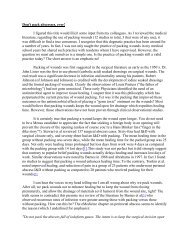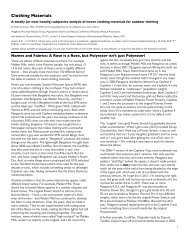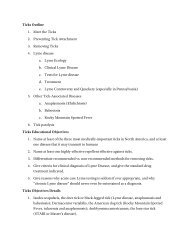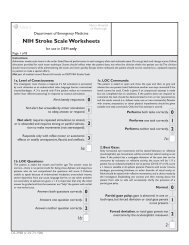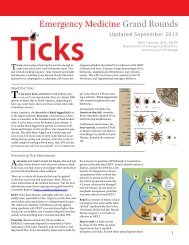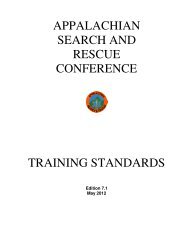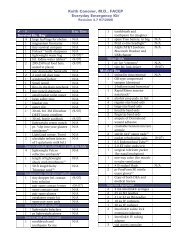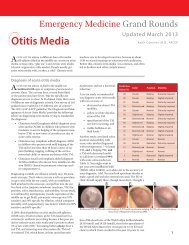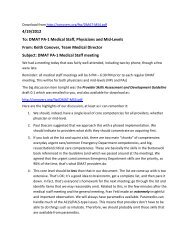pneumothorax BTS guidelines for the management of spontaneous
pneumothorax BTS guidelines for the management of spontaneous
pneumothorax BTS guidelines for the management of spontaneous
Create successful ePaper yourself
Turn your PDF publications into a flip-book with our unique Google optimized e-Paper software.
Downloaded from thorax.bmj.com on 17 August 2008<br />
ii48<br />
Henry, Arnold, Harvey<br />
thoracotomy <strong>for</strong> <strong>the</strong> treatment <strong>of</strong> complicated <strong>spontaneous</strong><br />
<strong>pneumothorax</strong>.<br />
Video assisted thoracoscopic surgery (VATS)<br />
The evaluation <strong>of</strong> VATS <strong>for</strong> <strong>spontaneous</strong> <strong>pneumothorax</strong> is limited<br />
by <strong>the</strong> small number <strong>of</strong> randomised trials comparing it<br />
with alternative surgical approaches. To date, <strong>the</strong>re have only<br />
been two randomised studies which have attempted to define<br />
<strong>the</strong> role <strong>of</strong> VATS in <strong>the</strong> treatment <strong>of</strong> <strong>spontaneous</strong><br />
<strong>pneumothorax</strong>. 120 137 In a comprehensive review, Massard and<br />
colleagues 99 have suggested that <strong>the</strong> impression that VATS is<br />
superior to open procedures in terms <strong>of</strong> morbidity, time in<br />
hospital, and cost may not be wholly correct. Minimally<br />
invasive surgery may have a complication rate similar to open<br />
procedures at about 8–10%. 120 122 138 Recurrence rates <strong>of</strong><br />
114 127<br />
<strong>pneumothorax</strong> after VATS are 5–10%, which are higher<br />
than <strong>the</strong> 1% rates reported after open procedures. 110<br />
While<br />
bullectomy, pleurectomy, pleural abrasion, and surgical pleurodesis<br />
have all been shown to have reasonable success rates<br />
when carried out thoracoscopically, 120 122 128 139–141 <strong>the</strong>re are concerns<br />
associated with VATS per<strong>for</strong>med under local anaes<strong>the</strong>tic<br />
supplemented by nitrous oxide inhalation. These arise from<br />
<strong>the</strong> inability to obtain isolated single lung ventilation and<br />
include difficulties in inspecting <strong>the</strong> entire visceral pleural<br />
surface, increasing <strong>the</strong> risk <strong>of</strong> missing a leaking bleb or<br />
123 142<br />
bulla. It is also suggested that a less intense pleural<br />
inflammatory reaction is induced by VATS procedures leading<br />
to a less effective pleurodesis. 143 Several authors suggest that<br />
VATS <strong>of</strong>fers significant advantages over open thoracotomy<br />
114 120 127 138 142<br />
including a shorter postoperative hospital stay,<br />
120 125 143 144<br />
significantly less postoperative pain, and better<br />
pulmonary gas exchange in <strong>the</strong> postoperative period. 145 However,<br />
Kim and colleagues in <strong>the</strong>ir randomised controlled trial<br />
did not confirm a shorter postoperative stay in <strong>the</strong> VATS<br />
groups. 137<br />
Fur<strong>the</strong>r randomised trials comparing VATS with transaxillary<br />
and open thoracotomies are required and, until <strong>the</strong>se data<br />
are available, VATS cannot be considered to be established as<br />
being superior to thoracotomy. 144 Waller and colleagues 146 suggested<br />
that, while VATS may be <strong>the</strong> preferred surgical<br />
procedure <strong>for</strong> young fit people with complicated or recurrent<br />
primary pneumothoraces, it is less reliable in cases <strong>of</strong> secondary<br />
<strong>pneumothorax</strong>. In cases <strong>of</strong> secondary <strong>pneumothorax</strong>, open<br />
thoracotomy and repair is still <strong>the</strong> recommended approach<br />
and VATS procedures should be reserved <strong>for</strong> those who might<br />
not tolerate an open procedure because <strong>of</strong> poor lung function.<br />
4.6 Discharge and follow up<br />
• Patients discharged without intervention should<br />
avoid air travel until a chest radiograph has confirmed<br />
resolution <strong>of</strong> <strong>the</strong> <strong>pneumothorax</strong>. [C]<br />
• Diving should be permanently avoided after a <strong>pneumothorax</strong>,<br />
unless <strong>the</strong> patient has had bilateral surgical<br />
pleurectomy. [C]<br />
• Primary <strong>pneumothorax</strong> patients treated successfully<br />
by simple aspiration should be observed to ensure<br />
clinical stability be<strong>for</strong>e discharge. Secondary <strong>pneumothorax</strong><br />
patients who are successfully treated with<br />
simple aspiration should be admitted <strong>for</strong> 24 hours<br />
be<strong>for</strong>e discharge to ensure no recurrence. [C]<br />
Patients with <strong>spontaneous</strong> pneumothoraces who are discharged<br />
without active intervention should be advised to<br />
return <strong>for</strong> a follow up chest radiograph after 2 weeks. These<br />
patients should be cautioned against flying until a follow up<br />
chest radiograph confirms full resolution <strong>of</strong> <strong>the</strong> <strong>pneumothorax</strong>.<br />
Commercial airlines currently arbitrarily advise that <strong>the</strong>re<br />
should be a6weekinterval between having a <strong>pneumothorax</strong><br />
and travelling by air. A recent chest radiograph should confirm<br />
resolution <strong>of</strong> <strong>the</strong> <strong>pneumothorax</strong>. A patient with a current<br />
closed <strong>pneumothorax</strong> should not travel on a commercial<br />
flight. There is no evidence that air travel precipitates<br />
recurrence <strong>of</strong> a <strong>pneumothorax</strong>, but recurrence during a flight<br />
may have serious repercussions. The <strong>BTS</strong> Air Travel Working<br />
Party stress that patients may travel safely 6 weeks after a<br />
definitive surgical procedure or resolution <strong>of</strong> <strong>the</strong> <strong>pneumothorax</strong><br />
on <strong>the</strong> chest radiograph. O<strong>the</strong>rwise, <strong>the</strong>re is still a significant<br />
risk <strong>of</strong> recurrence <strong>for</strong> up to 1 year, depending on whe<strong>the</strong>r<br />
<strong>the</strong> patient has underlying lung disease or not. Patients,<br />
particularly those who have suffered a secondary <strong>spontaneous</strong><br />
<strong>pneumothorax</strong>, may decide to avoid <strong>the</strong> risk by avoiding flying<br />
<strong>for</strong> a year in <strong>the</strong> absence <strong>of</strong> a definitive surgical procedure. 147<br />
After a <strong>pneumothorax</strong>, diving should be discouraged permanently<br />
unless a very secure definitive prevention strategy such<br />
as surgical pleurectomy has been per<strong>for</strong>med. 148<br />
The <strong>BTS</strong><br />
<strong>guidelines</strong> on respiratory aspects <strong>of</strong> fitness <strong>for</strong> diving 149<br />
deal<br />
with this in greater detail.<br />
Patients with primary <strong>pneumothorax</strong> treated successfully<br />
by simple aspiration should be observed to ensure clinical stability<br />
be<strong>for</strong>e discharge. The few patients with secondary<br />
<strong>pneumothorax</strong> who are successfully treated with simple aspiration<br />
should be admitted at least overnight and preferably <strong>for</strong><br />
24 hours be<strong>for</strong>e discharge to ensure no recurrence. The<br />
mortality rate associated with secondary <strong>pneumothorax</strong> is<br />
10%, and many <strong>of</strong> <strong>the</strong>se patients die after <strong>the</strong> <strong>pneumothorax</strong><br />
has resolved. 18 32 Most patients with secondary <strong>pneumothorax</strong><br />
will require a more protracted admission, including treatment<br />
<strong>of</strong> <strong>the</strong>ir underlying lung disorder. 32<br />
All patients discharged<br />
after active treatment or o<strong>the</strong>rwise should be given verbal and<br />
written advice to return to <strong>the</strong> Accident and Emergency<br />
department immediately should <strong>the</strong>y develop fur<strong>the</strong>r breathlessness.<br />
5 PNEUMOTHORAX AND AIDS<br />
• Early and aggressive treatment <strong>of</strong> pneumothoraces<br />
in HIV patients, incorporating intercostal tube<br />
drainage and early surgical referral, is recommended.<br />
[B]<br />
There is evidence that <strong>the</strong> clinical spectrum <strong>of</strong> <strong>spontaneous</strong><br />
<strong>pneumothorax</strong> is shifting away from <strong>the</strong> predominant<br />
subpleural bleb disease as emphasised by most reports since<br />
Kjaergard. 3 There are several reports that up to 25% <strong>of</strong> <strong>spontaneous</strong><br />
pneumothoraces in large urban settings with a high<br />
prevalence <strong>of</strong> HIV infection are AIDS related 31 32 150 ; 2–5% <strong>of</strong><br />
AIDS patients will develop a <strong>pneumothorax</strong>. 151–153 Pneumocystis<br />
carinii infection should be considered as <strong>the</strong> most likely<br />
aetiology in any HIV positive patient who develops a<br />
<strong>pneumothorax</strong>, although <strong>the</strong> administration <strong>of</strong> aerosolised<br />
pentamidine has also been suggested as an independent risk<br />
factor. 151<br />
Pneumocystis carinii pneumonia (PCP) is associated<br />
with a severe <strong>for</strong>m <strong>of</strong> necrotising alveolitis in which <strong>the</strong> subpleural<br />
pulmonary parenchyma is replaced by necrotic thin<br />
walled cysts and pneumatoceles. 154 155 AIDS related <strong>spontaneous</strong><br />
<strong>pneumothorax</strong> is complicated by <strong>the</strong> refractory nature <strong>of</strong><br />
air leaks which tend to occur with <strong>the</strong> necrotising subpleural<br />
pneumonitis <strong>of</strong> PCP infection. 156<br />
Such is <strong>the</strong> relationship<br />
between AIDS related <strong>pneumothorax</strong> and <strong>the</strong> presence <strong>of</strong> P<br />
carinii that <strong>the</strong> occurrence <strong>of</strong> <strong>pneumothorax</strong> in AIDS patients<br />
is considered an indicator <strong>of</strong> treatment <strong>for</strong> active P carinii<br />
infection. 151 AIDS related <strong>spontaneous</strong> <strong>pneumothorax</strong> carries<br />
a higher hospital mortality, a higher incidence <strong>of</strong> bilateral<br />
(40%) and recurrent pneumothoraces, and more prolonged air<br />
leaks. 157<br />
Treatment failures may also reflect <strong>the</strong> degree <strong>of</strong><br />
immunocompromise <strong>of</strong> <strong>the</strong> impaired host as reflected by <strong>the</strong><br />
CD4 counts. 157<br />
It has also been suggested that systemic<br />
corticosteroids used to treat PCP may increase <strong>the</strong> risk <strong>of</strong> morbidity<br />
from AIDS related <strong>pneumothorax</strong>. 158<br />
Because <strong>of</strong> <strong>the</strong><br />
high rate <strong>of</strong> primary treatment failures and associated short<br />
159 160<br />
survival times reported <strong>for</strong> such patients, early and<br />
www.thoraxjnl.com



